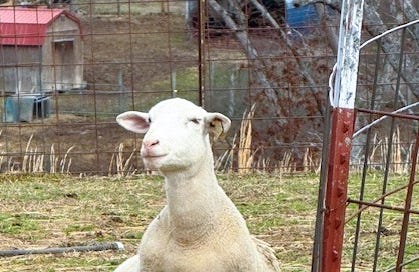It’s 5 a.m. when I step out into the cold morning. Lambing season is nearly upon us, and late night and early morning welfare checks on the flock are now the norm. Once lambing gets into full swing, midnight and 3 a.m. visits to the barn and paddocks will be added. But that is still perhaps a few days away. Some of the girls—the smaller-framed Dorpers in particular—already look like WWI dreadnoughts, each a battleship low and wide, waiting to unload its contents.
I let the dogs off the back porch for an early morning run. Both charge out the door in a skittering rush. They are on the trail of a skunk, whose presence in the chill air is made immediately and effectively known. Farther away in the dark, a coyote yips its unworldly cry. It is answered by others of its kind, first on the opposing ridge, then down in the creek bottom across the road, and finally, above me in the distant woods. In response, dogs throughout the valley erupt in a howling, barking, mad rejoinder, a chorus to the perceived threat. This goes on for the next twenty minutes, before, and almost altogether, quiet descends again in the predawn.
In the barn, I turn on the lights and enter the adjoining feeding corral through a side gate. The squeak of the gate hinge will on occasion bring the entire flock of sheep to its feet, ready to storm the feed troughs. Mercifully, this morning, the mob seems to understand that it is not yet feeding time and remains resting peacefully in the barn. (Whether the sheep are to be found in the barn or out in the corral depends on the weather and dryness of the ground. Today, after the heavy rains of the previous week, they are all inside on the fresh bedding.)
I shine my light around the outer corral. I need to make sure that there are no ewes outside in the cold and damp. None stands off to herself, pawing or sniffing at the ground for a yet-nonexistent lamb, and I hear no tiny bleats from afar, so I choose not to linger and risk further disturbance by my presence. The sheep will be up and about soon enough to let me know in their own insistent ways that they want attention.
I stop once more in the barn to admire the replacement headgate that my great-nephew and I have installed the day before. He and I have been rebuilding the old cattle chute that Cindy and I constructed some twenty-five years ago. A few posts were rotten and had to be dug out of the tightly packed dirt, one jarring slam of the post hole digger at a time, before new posts were set and anchored in concrete. All that remains to be done is to cut and attach new wooden railings, a job we will tackle in a few days.
I turn off the barn lights and head toward the house. Buster and Max are down in the ravine barking, having cornered an unknown quarry. I call them off and they return, exhilarated by their early morning run. I am relieved to note that neither has been sprayed by a skunk in their encounter. We three walk back to the house. A light is on in the popup trailer where my nephew camps out during his visit. All is quiet in the valley, giving the roosters an opportunity to make their presence known this late winter’s morning. I close the dogs on the back porch, pour myself a cup of coffee, and settle into my chair to read a book for a bit before the day properly begins.
………………………………………………..
Reading this week: The long essay “The Presence of Nature” from A Small Porch (W. Berry) and Cocktail Time (P.G. Wodehouse, of course). Just starting Red Hills and Cotton, an upcountry memory (B. Robertson).





Beautifully said. I've got a sow ready to farrow today, and my son is old enough to do those early morning checks. He loves it, and never complains about the lack of sleep. I suppose he's tough enough to know that early mornings and late nights are what separate him from the competition in 4-H and otherwise. Many blessings to you, your lambs, your family, and your dogs. Glad I stumbled upon your work.
That Berry is essay in ‘A Small Porch’ is such a rich literary journey through the past. Inspires one to take part in the succession of the agrarian peasant through the ages.